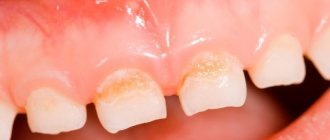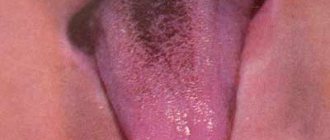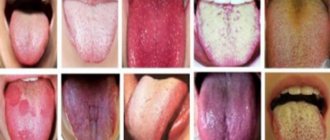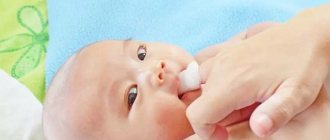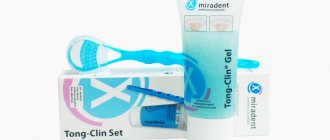A young mother tries to notice the first signs of any disease in her baby, so she closely looks at every fold and spot on the baby’s skin. Many parents have encountered such a phenomenon as a white coating on the tongue of a baby. In most cases, this is considered normal, but there are exceptions in which you need to consult a doctor. What factors need to be considered? Why does my baby have a white coating on his tongue? First of all, it is important to understand the baby’s nutrition: whether he drinks breast milk or is fed a special baby formula.
White coating on the tongue of a baby during breastfeeding
Mother's milk is not as rich as formula, so in the first months the baby may nurse almost every 30 minutes. Due to the constant presence of milk in the mouth, a baby may have a coating on his tongue throughout the day, and this is absolutely normal. Until approximately 3-4 months of life, the baby's salivary glands are underdeveloped and do not produce enough saliva. This is why a white coating forms on the baby’s tongue.
There is no need to clean off such a coating on a baby’s tongue; it does not bother the baby at all and does not cause discomfort, because it is ordinary mother’s milk, which does not have time to be washed off the tongue. When the baby’s condition is normal, he is cheerful, cheerful and actively suckles at the breast - there is no reason to worry.
How is plaque formed?
Epithelial cells on the surface of the tongue are constantly exposed to fairly aggressive factors: acidic foods, temperature changes, bacteria. That is why their lifespan is not long and after they are exfoliated, young cells appear. If the processes of changing cellular layers are excessively active, then the upper layers do not have time to peel off and remain on the surface of the mucosa in the form of plaque.
Another factor in the formation of plaque can be microorganisms. Children often do not pay enough attention to oral hygiene, as a result of which microscopic particles of food can remain between the lingual papillae, which become a place for active reproduction of bacteria. Taking antibacterial drugs often provokes the growth of pathogenic microflora in the mouth (fungi), some varieties of which are quite brightly colored.
White coating on the tongue of a bottle-fed baby
Formula-fed babies, like infants, eat very often in the first months of life and are thus constantly in contact with milk. Residues from such food may remain on the baby's tongue and cause plaque to form. However, in such children, the plaque should disappear 1-2 hours after feeding, since the intervals between meals are slightly longer than when breastfeeding.
The deposits from milk or formula are easily washed off with water, so you can do a little experiment. Invite your baby to drink water from a bottle or spoon (it should wash away most of the plaque), but if this does not happen, then you better contact your pediatrician. The doctor will be able to find out the cause of the white plaque in the baby and prescribe appropriate treatment. What else can cause deposits in a baby's mouth?
Newborn hygiene
The long-awaited moment has arrived. You and your baby are finally being discharged from the maternity hospital. While you were in the maternity hospital, the department staff helped you in caring for your child, and everything seemed clear and understandable. But when you are left at home, alone with your baby, everything seems much more difficult. So that you don’t get confused, let’s talk about newborn hygiene once again.
How to care for the umbilical wound
Why and why? The umbilical cord usually falls off on days 3-5 of the child's life. In its place remains the so-called “umbilical wound”, which heals by 10-14 days of life. In order to speed up the healing process and prevent infection from entering the wound, it is necessary to care for it daily. It is more convenient to treat the umbilical wound after bathing the child. It's not difficult at all, you can do it!
So, you will need: sterile cotton swabs, 3% hydrogen peroxide solution, salicylic alcohol.
- First you need to: remove rings and watches from your hands, wash your hands thoroughly.
- Unwaddle the baby, wash him if necessary and place him on the changing table.
- Using the thumb and forefinger of your left hand, spread the edges of the umbilical ring (with your index finger, pull the skin above the navel up towards the chest, and with your thumb, pull the skin under the navel down).
- Now take a bottle of peroxide in your right hand and drop 1-2 drops directly onto the umbilical wound. Wait 20-30 seconds until the peroxide fizzes and foams - it washes away the dead crusts, cleaning the wound. Continuing to hold the skin in the navel area with your left hand, take a sterile cotton swab with your right hand and dry the umbilical wound with gentle blotting movements. There is no need to try to remove those crusts that have not separated on their own - their time has not yet come. Perhaps they will disappear tomorrow or in a day.
- Take another cotton swab, dip it in salicylic alcohol, and spread the edges of the umbilical ring again. Gently but thoroughly blot the umbilical wound with the stick, and then wipe the skin around the navel in a circular motion.
- Let the alcohol dry for a few seconds
- That's all. You can put a diaper on your baby and swaddle him.
How to wash a newborn baby
Why and why? The skin of babies is much more delicate than that of adults, irritation and diaper rash occur very easily, so you need to wash the baby every time after he has had a bowel movement. In addition, keeping the skin clean helps your baby develop the first skills of neatness.
If you are away from home, you can use special baby wipes instead of washing, but you should not completely replace washing with such a simplified skin treatment.
A little trick. Babies tend to have a bowel movement after or during each feeding. This leads to the conclusion that washing before eating is a thankless task.
- The first thing you need to do is roll up your sleeves, remove rings and watches from your hands, adjust the temperature and pressure of running water. Prepare a thin diaper to dry the skin after washing. It is very convenient to just hang it on your shoulder and always have it at hand.
- Unwaddle your baby and remove his diaper.
- It is more comfortable to hold the baby with your left hand and wash it with your right.
- The boy is held face down when washing. Take the baby so that his chest lies across your forearm, while you hold his shoulder with the fingers of your left hand. Oddly enough, but hanging in this position, the baby does not experience the slightest discomfort.
- The girl needs to be washed only from front to back, so as not to contaminate her genitals. Place the child's back on the forearm of your hand, so that the head is on the bend of the elbow, and you will hold her left thigh with your fingers. This position allows you to securely hold the baby, and leaves you complete “freedom of action.”
- Wash your baby by scooping water into your palm using gentle movements from top to bottom, carefully removing dirt from the skin. It is especially important to wash all skin folds where dirt can accumulate and cause irritation. Do not use soap unless absolutely necessary; washing with soap once a week is sufficient.
- When washing the girl, there is no need to “rub” the genitals, since the mucous membrane is very delicate. In addition, overzealous washing removes the protective lubricant that protects the genitals from pathogens.
- After washing, dry your baby's skin. First, wrap the diaper over your baby's lower body and transfer him to the changing table. Then thoroughly blot the genitals, groin, buttocks and popliteal folds.
- If necessary (irritation), treat skin folds with a small amount of baby oil.
- Your baby is happy with life again. Now it would be good to “air out the butt” for 5-10 minutes before putting on a new diaper.
Bathing a newborn
Why and why? Bathing a newborn (hygienic bath) is carried out for all healthy children after the umbilical remnant falls off. Before the umbilical wound heals, it is recommended to bathe the baby in boiled water or running water, but you need to add a solution of potassium permanganate (potassium permanganate) to it.
Until your baby is six months old, it is advisable to bathe him daily; in the second half of his life, you can do this every other day. As a rule, children really like to swim, because before birth, water was their natural element. In water, the muscles relax, the child feels comfortable and calm. The duration of bathing in the first year of life is 5-10 minutes. Washing with soap is carried out no more than once a week. It is advisable to bathe the child no earlier than an hour after feeding, preferably 10-15 minutes before evening feeding.
It is more convenient to bathe a newborn baby together; most often, the father is called upon to help, and in many families, bathing the baby is exclusively the father’s “honorable mission.” Large and reliable male hands hold the baby’s tiny body with amazing tenderness, which contributes to the emergence and development of close contact between the child and the father, who at these moments feels very needed. But if you have to do without an assistant, don’t worry, you can do it just fine on your own.
IMPORTANT! If your baby is unwell, has a fever or signs of skin irritation, it is better to postpone bathing until you consult your pediatrician.
You will need: a baby bath, a jug of warm water for rinsing the baby, a special water thermometer, baby soap, a terry mitten, a large terry towel, a diaper, baby oil, a changing table with prepared clothes for the baby, cotton swabs with limiters or cotton swabs.
If the umbilical wound has not yet healed, prepare two containers with cold and hot boiled water or a solution of potassium permanganate to add to running water. The solution of potassium permanganate must be added to the water “drop by drop” until the water turns a faint pink color. Before using potassium permanganate, make sure that the crystals are completely dissolved, as getting a potassium permanganate crystal on the skin can cause a burn.
The air temperature in the room while bathing the child should be 22-24 degrees. You can bathe your baby in the bathroom, if it is spacious enough, or in the kitchen.
- First of all, you need to prepare the bath - wash with a brush and soap and rinse with boiling water. Place the bath in a stable, comfortable position and fill it ½ full with water. First pour cold and then hot water to avoid steam formation. Now you need to immerse the thermometer in water. The temperature of the water in the bath should be 37-37.5 degrees. Measuring the water temperature with your elbow is only possible if you have sufficient experience; a thermometer is always more reliable.
- Lay out the baby's clothes on the changing table, lay a towel on top, and place a diaper on it for wiping. However, you can put the diaper near the bath to make it more convenient for you to take it.
- Undress the child and, if necessary, wash him. Take the baby so that the head rests on the forearm of your left hand, and hold the baby’s left shoulder joint with your fingers (the thumb clasps the shoulder from above, place the other fingers in the armpit). Use your right hand to support the baby's buttocks and legs.
- Slowly immerse the baby in the bath: first the buttocks, then the legs and torso. Continue to support the baby's head with your left hand, leaving your right hand free for washing. The water level should reach the baby's armpits.
- Swing the child on the water back and forth, left and right. Your movements should be smooth and unhurried. Smile at your baby and talk to him affectionately.
- If you plan to wash the child with soap, then the “mitten” is put on the right hand. Lather your body using gentle circular motions and immediately rinse the soaped areas. First, wash your head from the forehead to the back of the head, then your neck, arms, chest, abdomen, legs. Rinse skin folds thoroughly. Lastly, wash your buttocks and genitals.
- Remove the baby from the water with its back facing up. Rinse your body and wash your baby's face with water from a jug. Place a diaper on the baby, place him on the changing table, and dry the skin with gentle blotting movements.
- Dry your ears with cotton swabs or cotton swabs.
- Lubricate the folds of the skin with baby oil. If necessary, treat the umbilical wound.
- Swaddle or dress your baby.
Now, to feel complete happiness, it would be nice for your baby to eat and sleep.
Morning toilet of a newborn
Why and why? We all know that “cleanliness is the key to health,” so every day we wash ourselves, brush our teeth, take a shower or bath. Without these usual hygiene procedures, a person feels uncomfortable. For a newborn baby, daily skin care is much more important than for an adult; in addition, the first habits of cleanliness begin to form unconsciously at such an early age.
The baby's daily toilet consists of washing, treating the eyes, nose, and skin folds. Until the umbilical cancer heals, it also needs to be treated daily. You need to wash your child after a night's sleep and during the day every time the child has had a bowel movement. The ears are treated as necessary in case of contamination and dried after each bathing. Children's nails are trimmed as they grow.
You will need: cotton pads (cosmetic pads), cotton wool for making flagella, baby oil or Vaseline, a container with warm boiled vodka, a container for used materials, scissors with rounded ends, cotton swabs with limiters, a set for treating the umbilical wound.
- First you need to remove rings and watches from your hands and wash your hands. Prepare everything you need: open a bottle of oil,
- wash the water container with soap, scald with boiling water, fill with warm boiled water,
- twist nasal flagella from small pieces of cotton wool, about 3 cm long and 2-3 mm in diameter,
- prepare a kit for treating the umbilical wound.
Now that you have everything at your fingertips, let's get down to business!
Washing and eye care
Washing a newborn baby is done with warm boiled water using cotton pads. Children over 3 months can be washed with running water.
Take a cotton pad, moisten it with water, squeeze lightly (so as not to drip). Wipe your baby's face in the following order: forehead, cheeks and, lastly, the area around the mouth. Discard this disc.
Then treat your eyes with separate cotton pads for each eye, moistened with warm boiled water, from the outer corner of the eye to the inner.
Take a dry cotton pad and dry your child's face in the same sequence.
Caring for the nasal passages
The nasal passages of a newborn baby are cleaned if there are crusts in them with soft cotton wool flagella moistened with petroleum jelly or baby oil.
Do not use cotton swabs on a hard base. The right and left nostrils are cleaned alternately with separate flagella. The flagella are inserted into the nose with careful rotational movements, no deeper than 1-1.5 cm.
Care for skin folds
To treat skin folds, use baby or Vaseline oil. Ready-made baby wipes impregnated with oil are quite convenient. You can moisten a cotton pad with oil, or you can simply apply it to your palms.
IMPORTANT! You cannot use oil and powder at the same time, because in this case the powder will roll into lumps, which can cause skin irritation and diaper rash.
First, lubricate the folds of the upper half of the body (from top to bottom) - behind the ears, cervical, axillary, elbow, wrist. Then, with another tampon, fold the lower half of the body (from bottom to top) - ankle, popliteal, inguinal, buttock.
Now, so that the baby does not look like an oil donut, excess oil from the skin needs to be removed with a dry cotton pad.
Ear care
The ears and external auditory canals should be dried from water after bathing. It is very convenient to use ready-made “ear” cotton swabs with limiters. If you don’t have them, you can make small tampons out of cotton wool. Dry your baby's ears with gentle blotting movements using separate swabs.
If discharge (earwax) has accumulated in the external auditory canal, you need to clean it using cotton swabs with limiters or cotton swabs soaked in Vaseline or baby oil. Insert the flagellum into the external auditory canal with careful rotational movements to a depth of no more than 0.5 cm. Use a separate flagellum for each ear canal.
Trimming nails
A newborn baby's nails need to be trimmed as they grow on his hands and feet to prevent the baby from scratching himself. Special children's scissors with rounded ends are convenient and safe.
A little trick. Many mothers are afraid of the thought that they will have to cut the nails on such tiny fingers that are constantly in motion. Therefore, everyone will be calmer if they do this “delicate work” when the baby is sleeping.
Take the child's hand so that only one finger remains free, on which you are going to trim the nail. Grab the finger with the thumb and index fingers of your left hand, holding it on both sides, and with the remaining fingers of your left hand you can hold the child’s other fingers.
Fingernails are trimmed in a semicircle, and toenails are trimmed in a straight line to avoid future problems such as ingrown toenails. You need to trim your nails with continuous movements of the scissors, and not “piece by piece.” Please check if there are any protruding sharp parts left on the nails.
Don’t forget to carefully collect the trimmed nails so that if they get lost in the folds of clothes and linen, they won’t injure your baby’s skin.
Causes of white plaque on a child’s tongue
Let's find out the opinions of professionals. What does Dr. Komarovsky say about plaque on the tongue in infants? Like most doctors, he identifies the following reasons:
- dysbacteriosis and gastritis;
- stomatitis;
- intestinal dysfunction;
- other pathologies.
Every mother should arm herself with recommendations that will help her prevent a similar condition in her child. After plaque has already appeared, be sure to consult a doctor who can determine the exact cause of its appearance and prescribe the necessary treatment.
Therapy methods
Treatment of candidiasis begins with treatment of the oral cavity. The first procedure is performed by a specialist at the appointment. Antiseptic agents are used to remove plaque. The doctor may then apply an antifungal agent.
The parent should closely monitor the dentist’s actions, since in the future they will have to treat the oral cavity themselves at home. The necessary medications will be prescribed by a specialist. Local antifungal agents are dangerous in case of overdose, especially for children, so you must strictly follow your doctor’s recommendations.
In advanced cases, medications are prescribed in the form of solutions, drops or tablets. There are few drugs available to treat candidiasis in children. Replacing them with adult counterparts is also dangerous. The dosage must be strictly observed.
A mandatory addition to the main therapy is maintaining good hygiene, good sleep, proper nutrition and taking measures to strengthen the immune system (eating healthy foods, taking pharmaceutical vitamins if necessary, walking, etc.).
Maybe it's thrush?
Thrush, or candidiasis, is an infectious disease caused by fungi (Candida). Doctors often use the term “candidiasis” and claim that most children under one year of age suffer from this disease. The appearance of thrush most often manifests itself in the first 3 months of a child’s life, since during this period of life his oral cavity is not yet populated by healthy microorganisms, and the immune system, alas, is not strong enough.
What is the cause of plaque on the tongue of a baby at an older age? It happens that the immune system does not work properly and a fungal infection appears in the child's mouth or cheeks. Against the background of reduced immunity, for example after a respiratory viral infection, the risk of developing thrush increases.
Fungal infection
The development of thrush in the child’s mouth occurs as a result of the growth of Candida fungi. Intensive reproduction of pathogenic microorganisms occurs as a result of the influence of various factors.
Often babies become infected with thrush during childbirth, crossing the birth canal
These include:
- Weakened immune system.
- Dysfunctions of the microflora of the gastrointestinal tract.
- Hormonal disorders.
- Conducting antibacterial therapy.
- Excessive dryness of the oral mucosa.
Infection with Candida fungi occurs under the following conditions:
- In utero. Infection can occur through the placenta, umbilical cord and amniotic fluid.
- During childbirth. Often babies become infected with thrush during childbirth, crossing the birth canal. Therefore, it is important for women to exclude the development of thrush, especially in the last stages of pregnancy.
- Finding a child in a hospital and maternity hospital. Inappropriate and non-sterile care of the child contributes to the child becoming infected from health care workers.
- Poor sanitary conditions at home. Babies are born with a weakened immune system. Therefore, keeping a child in an unsterile home environment promotes the penetration of various microorganisms and bacteria into his body.
Diagnosis of candidal glossitis involves a complete collection of anamnesis data and conducting various types of comprehensive research.
Important! In most cases, when diagnosing thrush in a child, an instrumental examination is not performed.
For these purposes the following is carried out:
- Microscopic examination of the oral mucosa by taking a scraping from plaque and then examining it under a microscope. This allows you to determine the presence of Candida mycelium threads and yeast-like cells.
- Bacteriological research. Allows you to identify the type of Candida fungus and the number of its colonies. Sowing mushrooms on a nutrient medium helps install the most effective antifungal drug. This is necessary, since many medications have different effects on grown fungal colonies.
- Serological study. It is carried out if necessary to study antibodies that are concentrated in the blood serum.
The difference between thrush and milk plaque
How to determine the cause of plaque on the tongue of a baby? If a person does not have the opportunity to see a doctor or a frightened mother cannot wait to determine the nature of the plaque, then simply try to wash it off with water. If the situation has not cleared up, perhaps the child does not want to drink water (this happens to children in the first weeks of life), do not worry, there is another simple way to determine the cause of plaque. Try to gently remove the plaque from your baby's tongue with clean hands or a cloth. The fact is that plaque from thrush cannot be removed so easily, and in those places where you still manage to clean the child’s tongue, you may notice a bleeding surface. This sign is considered an undeniable symptom of thrush, and your child needs urgent treatment.
The influence of thrush on the child’s condition
With candidiasis, the baby’s general condition worsens, he becomes capricious, lethargic and refuses to eat. Candida spots in the mouth cause severe discomfort to the baby; sucking the breast or bottle becomes painful for him, and because of this he constantly cries. In rare cases, there is an increase in body temperature, as with a cold, sometimes it reaches 39 degrees.
Candidiasis rarely affects only the tongue. Usually the entire oral cavity becomes covered with white spots, even the area around the mouth can be affected by the fungus. When the baby eats, the plaque peels off and disappears for a while, and the inflamed mucous membrane of the mouth is visible.
How to clean your tongue
Do not use regular toothbrushes for cleaning - they will not be able to remove plaque. It is better to pay attention to special tongue cleaning products.
Scrapers
The most common devices are scrapers. The tips of the scrapers are made in the shape of a spoon. They are usually made of plastic, sometimes with stiff bristles. The flat shape prevents the gag reflex that may occur when brushing the root of the tongue. This scraper needs to be changed every six months.
Irrigator attachments
Tongue attachments are also made in the form of a spoon. The irrigator, unlike a conventional scraper, delivers a stream of water, which additionally washes the surface of the tongue.
Attachments for electric brushes
Most brush manufacturers offer special attachments for their products to clean tongue deposits. As a rule, they have a flat, textured rubber surface.
Tongue gels
You should not clean your tongue with toothpaste - it is intended for teeth. Pastes contain abrasives and menthol, they can irritate the mucous membrane. Special gels that gently dissolve plaque and also disinfect the oral cavity are better suited for the tongue.
How to treat candidiasis in a baby?
Typically, your pediatrician should prescribe antifungal medications to treat oral thrush. Infants are given convenient dosage forms (syrup or solution) that should be used to lubricate the tongue and oral mucosa. The duration of treatment for plaque on the tongue of an infant depends on the degree of the disease, but is usually within 7-10 days. Feeling better occurs within 3-4 days.
The oral cavity is cleansed, and the child can begin to eat milk with renewed vigor, and then sleep peacefully. If it seems to you that the baby’s condition has returned to normal, this does not mean that you need to stop treatment. Candidiasis is a very persistent disease, and if you stop taking medications, the plaque and spots will definitely return. In this case, the fungus will become resistant to previously used drugs, and a new, most likely aggressive, treatment will have to be prescribed.
What does a normal tongue look like?
Photo: tongue of a healthy child
To an experienced therapist, the color of the tongue, the shape and nature of the spots and plaque covering it tell a lot about the health status of the little patient. Normally, the surface of the tongue should meet the following characteristics:
- rich pink color of the mucous membrane;
- smooth surface structure;
- absence of stains, plaque and other formations;
- pronounced papillae: the surface should be slightly rough.
Prevention of tongue thrush in infants
Do not forget about preventive measures to prevent the formation of candidiasis in the baby’s mouth. It is important to regularly ventilate and humidify the air in the room. Do not forget about the importance of walks in the fresh air, after them the baby’s sleep normalizes and the immune system is strengthened.
If a child is fed artificially, then you need to thoroughly wash all the items necessary for feeding (bottle, pacifier), and even the pacifier. When breastfeeding, it is important for the mother to monitor her health and not eat a lot of sweets, which can provoke active reproduction of the Candida fungus. There is no need to wash or wipe your breasts with antiseptic agents. The Candida fungus is present in the body of every person, and the further development of the infection depends only on the state of immunity.
Frequent washing of the mother's breasts can dry out the skin, resulting in the formation of microcracks, which are the main factor contributing to the appearance of thrush in the baby. If you are not sure about the cause of thrush in your child, consult your doctor for help. A competent pediatrician will prescribe the optimal treatment specifically for your case. If you determine the cause of the white coating on your baby’s tongue in time and complete the prescribed course of treatment, the likelihood of complications will be minimized.
Treatment
Fungal diseases in children can be treated by a pediatrician, an infectious disease specialist or a dermatologist. If we are talking about the treatment of oral thrush, then therapy can also be carried out by a dentist.
The diagnosis of candidiasis is determined in most cases based on an examination of the oral cavity performed by a specialist. If there is any doubt, the doctor refers the patient for additional examinations. More often, to confirm the disease, a laboratory test is used to test a smear taken from the mouth for the presence of fungus.
Treatment of thrush in children requires an integrated approach. If the disease is not advanced, then local therapy is carried out in combination with measures to strengthen the immune system. In severe cases, oral candidiasis in children is treated with systemic drugs, local agents and compliance with preventive recommendations.
Causes of yellow coating on a child’s tongue
The appearance of a yellow coating on a baby's tongue can seriously frighten parents. If such plaque lasts for a long time and looks like a thick dense mass, and at the same time a sharp, unpleasant odor is felt from the baby’s mouth, then this is a sign of a serious illness. Do not forget that the tongue is one of the organs of the digestive system, and changes in its color may indicate diseases of the gastrointestinal tract (pancreatitis, hepatitis, colitis, cholecystitis, gastritis).
Pathological changes in the digestive system are accompanied by a decrease in the child’s appetite, stool disturbances, and the baby’s crying (due to abdominal pain). There are other reasons for the appearance of a yellow coating on the tongue in an older child:
- overeating (the child may have eaten too much fatty food, resulting in nausea, dry mouth and a yellow coating on the tongue);
- infectious disease (infection is accompanied by high temperature, which provokes the formation of a yellow-brown coating, you can also notice bleeding wounds on the tongue);
- poisoning (in this case, liver function is disrupted, the body becomes intoxicated and dehydrated, which leads to the appearance of plaque);
- jaundice (the tongue itself and the mucous membranes of the mouth become stained);
- local inflammatory processes in the child’s mouth (caries, sore throat, gingivitis, stomatitis, glossitis);
- somatic diseases (autoimmune processes, diabetes mellitus and kidney disease).

